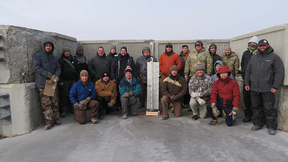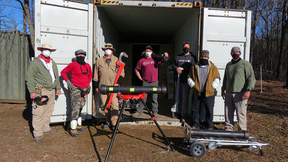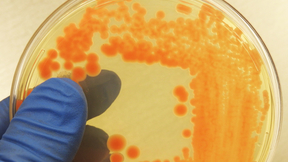- Additive manufacturing
- Advanced membranes
- American Physical Society
- ASC
- Astrophysics
- Atmospheric, Earth, and Energy
- Batteries
- Battery materials
- Bay Area Science Festival
- Biofuels sfa
- Biological Accelerator Mass Spectrometry
- Biosciences and Biotechnology
- Biosecurity
- Biosecurity & Bioscience
- Biosecurity and Bioforensics Group
- Biosecurity sfa
- Capacitive deionization
- Carbon nanotubes
- Carbonate materials
- Center for Accelerator Mass Spectrometry
- Center for Applied Scientific Computing
- Center for High Energy Density Science
- Charity
- Community
- Community gift program
- Computing & Simulation
- Counterterrorism
- COVID-19
- Ct vaccine center
- DARPA
- Data Science
- Data Science Institute
- Defense and Deterrence
- Discovery Center
- DOE
- Earth system science
- Education
- Emergency
- Energetic Materials Center
- Energy flow charts
- EOS and Materials Theory Group
- Expanding Your Horizons
- Forensic Science Center
- Fun with science
- Fundamental Science
- Fusion
- Gemini Planet Imager
- Glenn T. Seaborg Institute
- HEAF
- High Energy Density Science
- HOME Campaign
- HPC
- HPC Innovation Center
- HPC4Mfg
- Hydrogen production
- Hydrogen storage
- IEEE
- Inclusion
- Inertial confinement fusion
- Intelligence
- Internships
- Jupiter Laser Facility
- Laboratory for Energy Applications for the Future
- Laser Materials
- Lasers
- Lasers and Optical Science Technology
- Livermore Center for Quantum Science
- Livermore Computing
- Livermore Valley Open Campus
- Livermorium
- LLMDA
- LLNS
- Machine learning
- Materials Science
- Microbiology and Immunology Group
- Nanocrystal solar cells
- Nanoscience
- NanoSIMS
- National Ignition Facility
- Neural devices
- Neutrinos
- Newsline
- nEXO
- NNSA
- Nonproliferation
- npneq
- Nuclear
- Nuclear and Chemical Sciences
- Nuclear and Particle Physics Group
- Nuclear Chemical and Isotopic Science
- Nuclear forensics
- NuSTAR
- Office of Science
- Outreach
- Oxidation and degradation
- pcmdi
- People
- Periodic table
- Physics
- Planetary Defense
- Postdocs
- Procurement
- Quantum Simulations Group
- Rare-earth elements
- Rubin Observatory
- Science
- Science and Technology Review
- Science on Saturday
- Sequestration
- Soil microbiome sfa
- Solar
- Solar system
- Solid-state batteries
- Space
- Space Science Institute
- STEM
- Stockpile stewardship
- Students
- Summer Student Spotlight
- Supercapacitors
- Supercomputer
- Supercomputing
- Surface analysis
- Sustainability
- Technology Transfer
- Tours
- Transport system
- Traumatic brain injury
- User Facility
- Veterans
- Viruses
- Water
- Water research
- Weapons
- Women in STEM
- Women's Hall of Fame
- WWW Research Landing Page
- X-ray
Back
Biosecurity and Bioforensics Group
LLNL team demonstrates anisotropic explosive properties in key weapon safety study
Lawrence Livermore National Laboratory (LLNL) scientists and engineers led a multi-institutional team in executing a series of high explosives tests that successfully demonstrated fundamental principles of anisotropy, a possible enabler for improved weapon and munition safety. Working under snowy and frigid conditions on Idaho’s Snake River Plain, a 13-member team from…
LLNL weapon engineers, biologists deliver critical samples to identify skin proteins left on IEDs
Following a terrorist bombing, can the bomb maker be identified by skin proteins left on the bomb components they handled? To address this question, Lawrence Livermore National Laboratory (LLNL) personnel from Weapons Complex Integration (WCI) and Global Security (GS) Forensic Science and Biosecurity Centers (FSC/BSC) subjected notional bomb components handled by LLNL…
LLNL researchers salvage broken arrow samples
It was a cool spring day in May 2019. LLNL researchers Mark Hart, Matt Lyman and Salustra Urbin were combing through rusted propellers and a split Mk4 bomb case in the foothills of Manzano Mountain, just a few miles east of Kirtland Air Force Base in New Mexico. The LLNL team was exploring three different plane crashes that had occurred on the mountain, but it was the…
Newly developed tunable, green detergents could be 'made-to-order' for industry
That mascara that your colleague is wearing may contain components from a microorganism. Detergents, also known as surfactants, are used extensively in the cosmetics, oil, food, agriculture, healthcare and pharmaceutical industries. Their sales are projected to reach $42 billion by 2020. The majority of surfactants are petrochemicals, i.e. are synthesized from petroleum…









